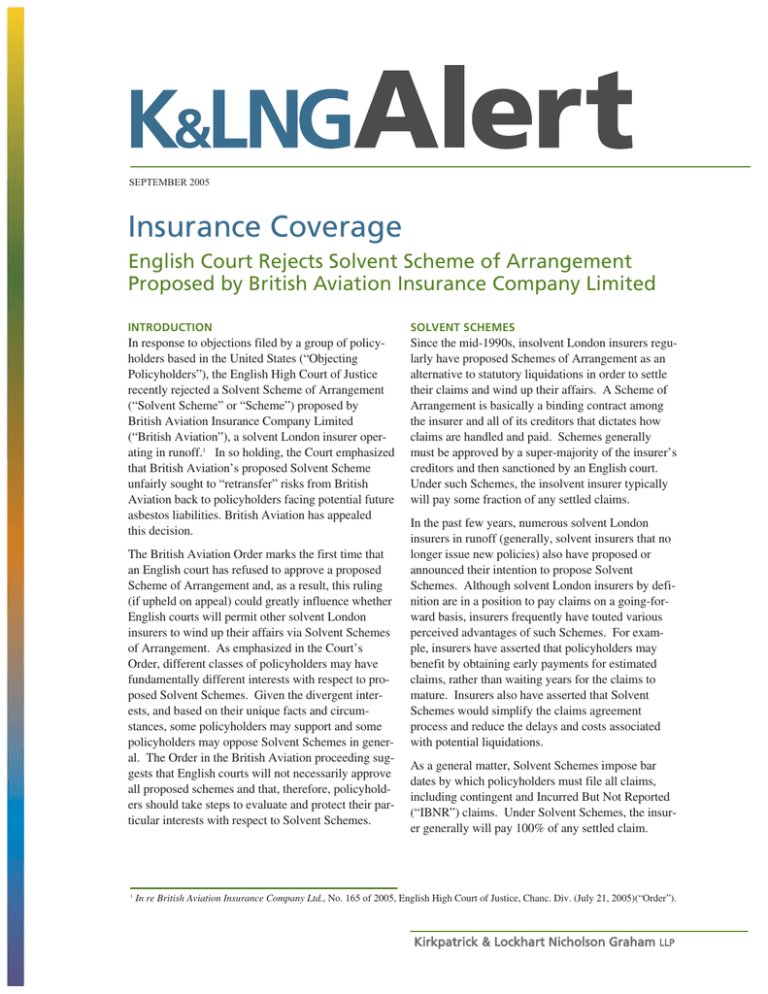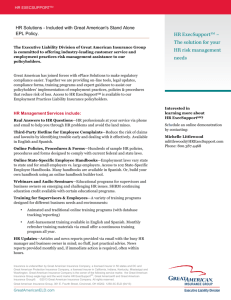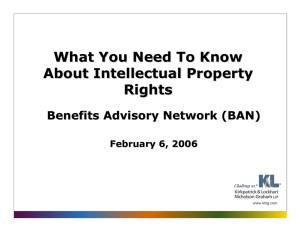
SEPTEMBER 2005
Insurance Coverage
English Court Rejects Solvent Scheme of Arrangement
Proposed by British Aviation Insurance Company Limited
INTRODUCTION
SOLVENT SCHEMES
In response to objections filed by a group of policyholders based in the United States (“Objecting
Policyholders”), the English High Court of Justice
recently rejected a Solvent Scheme of Arrangement
(“Solvent Scheme” or “Scheme”) proposed by
British Aviation Insurance Company Limited
(“British Aviation”), a solvent London insurer operating in runoff.1 In so holding, the Court emphasized
that British Aviation’s proposed Solvent Scheme
unfairly sought to “retransfer” risks from British
Aviation back to policyholders facing potential future
asbestos liabilities. British Aviation has appealed
this decision.
Since the mid-1990s, insolvent London insurers regularly have proposed Schemes of Arrangement as an
alternative to statutory liquidations in order to settle
their claims and wind up their affairs. A Scheme of
Arrangement is basically a binding contract among
the insurer and all of its creditors that dictates how
claims are handled and paid. Schemes generally
must be approved by a super-majority of the insurer’s
creditors and then sanctioned by an English court.
Under such Schemes, the insolvent insurer typically
will pay some fraction of any settled claims.
The British Aviation Order marks the first time that
an English court has refused to approve a proposed
Scheme of Arrangement and, as a result, this ruling
(if upheld on appeal) could greatly influence whether
English courts will permit other solvent London
insurers to wind up their affairs via Solvent Schemes
of Arrangement. As emphasized in the Court’s
Order, different classes of policyholders may have
fundamentally different interests with respect to proposed Solvent Schemes. Given the divergent interests, and based on their unique facts and circumstances, some policyholders may support and some
policyholders may oppose Solvent Schemes in general. The Order in the British Aviation proceeding suggests that English courts will not necessarily approve
all proposed schemes and that, therefore, policyholders should take steps to evaluate and protect their particular interests with respect to Solvent Schemes.
1
In the past few years, numerous solvent London
insurers in runoff (generally, solvent insurers that no
longer issue new policies) also have proposed or
announced their intention to propose Solvent
Schemes. Although solvent London insurers by definition are in a position to pay claims on a going-forward basis, insurers frequently have touted various
perceived advantages of such Schemes. For example, insurers have asserted that policyholders may
benefit by obtaining early payments for estimated
claims, rather than waiting years for the claims to
mature. Insurers also have asserted that Solvent
Schemes would simplify the claims agreement
process and reduce the delays and costs associated
with potential liquidations.
As a general matter, Solvent Schemes impose bar
dates by which policyholders must file all claims,
including contingent and Incurred But Not Reported
(“IBNR”) claims. Under Solvent Schemes, the insurer generally will pay 100% of any settled claim.
In re British Aviation Insurance Company Ltd., No. 165 of 2005, English High Court of Justice, Chanc. Div. (July 21, 2005)(“Order”).
Kirkpatrick & Lockhart Nicholson Graham
LLP
English courts have approved numerous Solvent
Schemes in the past few years, including Schemes
proposed by Ludgate Insurance Company and Sphere
Drake Insurance Company. It has been reported that
approximately sixty (60) solvent London insurers
have proposed or are in the process of proposing
Solvent Schemes.2
This trend has sparked a considerable amount of controversy in the policyholder community. While
Solvent Schemes may benefit certain policyholders
(particularly those that are in a position to support
contingent claims with actuarial data), their impact
on other policyholders remains unclear. For example, under a Solvent Scheme, policyholders would
not be able to file claims after the bar date, even if
they were unaware of the claims before the bar date.
Additionally, some have suggested that (i) it is
unclear how Scheme Administrators will value IBNR
claims, particularly for policyholders that may have
just recently become involved in asbestos-related
lawsuits; (ii) it is unclear whether Scheme
Administrators will handle claims fairly, given that
policyholders arguably lose the threat of suing the
insurer if the settlement is not reached or the insurer
acts in bad faith; and (iii) it is unclear whether
Scheme Adjudicators will handle disputes fairly.
BRITISH AVIATION’S PROPOSED
SOLVENT SCHEME
As noted above, British Aviation is the latest in a
series of solvent London insurers that have attempted
to wind up their affairs via a Solvent Scheme. British
Aviation was incorporated in 1930 and wrote insurance and reinsurance in the aviation sector until
approximately 2002.3 It was recognized as a “lead
underwriter in the aviation risks in which it participated.”4 British Aviation is a private company,
owned directly and indirectly by three major insur-
ance companies: Royal & Sun Alliance Insurance
Group, AVIVA plc, and AXA Investment Managers
UK Holdings Ltd.5
British Aviation is solvent. Its audited balance sheet
as of December 31, 2004 shows total assets of
£227,136,000 as against total liabilities to third parties of £125,997,000.6 As a result, if the Solvent
Scheme had been approved, the three insurance companies that owned British Aviation “stood to receive
a substantial return of capital.”7
British Aviation’s proposed Scheme was designed to
cover the majority, but not all, of its outstanding liabilities. Specifically, the proposed Scheme applied to
insurance and business underwritten by British
Aviation during the period February 24, 1930
through December 31, 1990 (as well as certain policies issued by its Canadian branch).8 With respect to
business excluded from the proposed Scheme, British
Aviation would remain in conventional solvent run-off.9
British Aviation’s main potential liabilities that
would have been affected by the proposed Scheme
are claims or potential claims by policyholders in the
United States under product liability and general liability insurance policies affording coverage for
claims arising out of exposure to asbestos, pollution,
and other health hazards.10 British Aviation estimated
that approximately 93% of its “estimated liabilities
before reinsurance” arose from pollution and asbestos
claims.11 British Aviation further estimated that
approximately 92% of its asbestos liabilities are
owed to direct insureds, all of whom are resident in
the United States.12
British Aviation held a meeting of creditors on
March 15, 2005. Seventy-seven policyholders
attempted to vote at the meeting; seventy-two of
them were admitted to vote. British Aviation reported that the requisite majority of creditors voted in
2
See Summary Schedule prepared by KWELM Management Services, May 2005.
3
See Order at ¶ 1.
4
Id. at ¶ 3.
5
Id. at ¶ 1.
6
Id. at ¶ 7.
7
Id. at ¶ 11.
8
Id. at ¶ 21.
9
Id. at ¶ 13.
10
Id. at ¶ 3.
11
Id. at ¶ 5.
12
Id. at ¶ 6.
2 SEPTEMBER 2005
KIRKPATRICK & LOCKHART NICHOLSON GRAHAM LLP
favor of the proposed Scheme, although there were
disputes concerning who was allowed to vote and
how certain policyholders’ claims should be valued
for voting purposes.13
Thereafter, eighteen corporations based in the United
States filed objections to the proposed Scheme on the
following grounds: (1) the process of notifying creditors of the proposed Scheme was fundamentally
flawed; (2) the information provided to the policyholders was inadequate; (3) the Court did not have
jurisdiction to sanction the plan because the company
failed to constitute the classes of its policyholders in a
proper manner; (4) only a small minority of British
Aviation’s policyholders voted in favor of the proposed Scheme; (5) the proposed Scheme was unfair,
and (6) British Aviation failed to make full and frank
disclosures concerning the proposed Scheme.14
THE COURT’S ORDER REJECTING
THE SOLVENT SCHEME
On July 21, 2005, the English High Court of Justice
denied British Aviation’s application to the Court for
sanction of the proposed Solvent Scheme. In sum,
the Court denied British Aviation’s application on the
grounds that it did not have jurisdiction to hear the
petition because British Aviation had failed to identify and secure the approval of all classes of creditors
in a correct manner. The issue presented to the Court
was whether British Aviation’s decision to treat all of
its creditors as a single class for voting purposes was
appropriate or whether certain policyholders—including policyholders with large IBNR claims—should
have been treated as a separate class. The Court
framed the question of “what is a ‘class’ of creditors”
as follows:
The relevant question at the outset is:
between whom is it proposed that a compromise or arrangement is to be made?
Are the rights of those who are to be
affected by the scheme proposed such that
the scheme can be seen as a single arrangement; or ought the scheme to be regarded,
on a true analysis, as a number of linked
arrangements?15
13
Id. at ¶¶ 41-44.
14
Id. at ¶¶ 46-52.
15
Id. at ¶ 57 (citing in Re Haw Insurance Company Ltd.).
16
Id. at ¶ 92.
17
Id. at ¶ 83.
18
Id. at ¶ 83.
3 SEPTEMBER 2005
The Court held that the Objecting Policyholders—
generally policyholders with IBNR claims—should
not have been grouped in the same class with other
policyholders, reasoning as follows:
In the particular circumstances of a solvent scheme, where a solvent liquidation
is not a realistic alternative, those with
accrued claims and those with IBNR
claims have interests which are sufficiently different as not to make it possible
for them sensibly to consult together “in
their common interest.” In truth, they do
not have a common interest at all.16
In so holding, the Court emphasized the differences
between policyholders with accrued claims and policyholders with IBNR claims. The Court noted that
policyholders with accrued claims will be paid in
full, whether the Scheme was approved or not.17 In
contrast, if the Scheme was approved, policyholders
with IBNR claims would merely gain the right to
have their claim “valued.” If the Scheme was not
approved, policyholders with IBNR claims would
simply wait for claims to materialize and the insurer
would bear the risk of whether such claims would
materialize and to what extent. The Court held that
“this is what insurance is about. The policyholder
bargains for the insurer to bear the risk of a contingency materializing. The insurer is in the risk business; and the policyholder is not. Unlike the policyholder with an accrued claim, who knows the extent
of his exposure to that claim, the policyholder with
an IBNR claim does not. The essence of the scheme
is that it retransfers the risk from the insurer (who
had contracted to bear it) to the policyholder (who
did not). Thus the rights of a policyholder with an
IBNR claim are fundamentally different under the
scheme from the rights that he would have in the
absence of the scheme.”18
In addition, the Court held that policyholders with
IBNR claims had fundamentally different interests
than certain creditors who voted in favor of the
Scheme who were also reinsurers of British
Aviation. The Court held that “as reinsurers, they
have a clear interest to cap their own liabilities to the
KIRKPATRICK & LOCKHART NICHOLSON GRAHAM LLP
Company under their own reinsurance contracts.”19
As such, the Court held that the creditors that were
also reinsurers “ought to have been constituted as a
separate class.”20
Given these conflicts among the creditors, the Court
held that the “single scheme meeting was not properly constituted. It follows, therefore, that I must hold
that I have no jurisdiction to sanction the scheme.”21
Although the Court based its decision on jurisdictional grounds, it stated that “in case I am wrong, I
must go on to consider the other grounds of objection.”22 In this dicta, the Court expressed reservations about the overall fairness of the proposed
Scheme as well and the conduct of the Creditors’
meeting. The Court stated that “if I had jurisdiction I
would not have sanctioned the scheme … [for the
following reasons:]
■
The votes allowed to be cast at the scheme
meeting did not fairly represent the creditors
(and in particular the direct insureds) with substantial IBNR claims;
■
The Estimate Methodology does not provide a
clear basis for treating all creditors alike, and
results in uncertainty;
■
The Company’s power to revert to runoff is not
circumscribed; and
■
The supposed benefits of the scheme are largely
benefits to the Company and its shareholders; or
are brought into existence by the exigencies of
the scheme itself.”23
With respect to the first point, the Objecting
Policyholders objected on the grounds that British
Aviation had greatly discounted the IBNR claims of
certain policyholders that voted against the Scheme,
while recognizing multi-million-dollar IBNR claims
of policyholders that voted in favor of the Scheme.24
19
Id. at ¶ 93.
20
Id. at ¶ 93.
21
Id. at ¶ 97.
22
Id. at ¶ 97.
23
Id. at ¶ 142.
24
Id. at ¶¶ 103 and 104.
25
Id. at ¶¶ 109-110.
26
Id. at ¶ 141.
27
Id. at ¶ 143.
28
Id. at ¶ 143.
4 SEPTEMBER 2005
While not reaching any definitive conclusions, the
Court stated that “I have a very uneasy feeling that
these IBNR claims were simply brushed aside.…
The real problem is that the votes of the policyholders with IBNR claims have to be estimated using
sophisticated and controversial actuarial techniques.
In such a case it seems to me that the court must be
especially wary of simply waving through a vote in
which so many of the dissentients have had a nominal value placed on their claims.”25
The Court further stated that any benefits arising
from an early conclusion of the runoff and any associated cost savings would “enure” to British
Aviation, rather than the policyholders.26
In conclusion, the Court stated that the “most powerful consideration” was that it is “unfair to require the
manufacturers who have bought insurance policies
designed to cast the risk of exposure to asbestos
claims on insurers to have that risk compulsorily
retransferred to them. [British Aviation] is in the risk
business; [the policyholders] are not.”27 The Court
recognized that while some policyholders may be
willing to accept payment in full based on an estimate of their claims, it was unfair to require all policyholders to settle. The Court reasoned that to compel objecting policyholders to take part in the Solvent
Scheme “would…require them to do that which it is
unreasonable to require them to do.”28
CONCLUSION
It remains to be seen whether the British Aviation
Order will be upheld on appeal and, if so, what
impact it will have in the future on Solvent Schemes.
Some commentators believe that Solvent Schemes
can be modified in order to ensure court approval.
For example, an insurer could insert provisions into a
Solvent Scheme that would allow IBNR claimants to
vote as a separate class and would provide greater
clarity of the estimation methodologies to be used to
KIRKPATRICK & LOCKHART NICHOLSON GRAHAM LLP
resolve claims.29 Future Solvent Schemes also could
treat insurance policyholder claimants differently
from cedent insurer claimants.
The impact of this decision can already be seen. For
example, at least one Solvent Scheme proposal has
been postponed in the wake of this decision.
Gordian Runoff (UK) Ltd. (formerly known as GIO
(UK) Ltd.) has adjourned its hearing to obtain court
approval of its proposed Solvent Scheme.
While the future of Solvent Schemes remains to be
seen, the British Aviation Order highlights the need
for policyholders to evaluate carefully any proposed
Solvent Schemes and to take action to protect their
interests.
Gregory S. Wright
gwright@klng.com
202.778.9250
Julia Reynolds Johnson
jjohnson@klng.com
202.778.9227
Gregory S. Wright is a partner and Julia Reynolds Johnson is
of counsel in the Washington, D.C. office of the law firm of
Kirkpatrick & Lockhart Nicholson Graham LLP. They regularly counsel policyholders with respect to a wide variety of
insurance coverage claims, including claims against insolvent London insurers. The views expressed in this Alert are
not necessarily those of Kirkpatrick & Lockhart Nicholson
Graham LLP or of its clients.
If you have questions or would like more information about K&LNG’s Insurance Coverage Practice, please contact
one of our lawyers listed below.
International Contact
Boston
Dallas
Harrisburg
London
Los Angeles
Miami
Newark
New York
Pittsburgh
San Francisco
Washington
29
Peter J. Kalis
John M. Edwards
Robert Everett Wolin
Carleton O. Strouss
Jane V. Harte-Lovelace
David P. Schack
Daniel A. Casey
Anthony P. La Rocco
Peter J. Kalis
John M. Sylvester
Edward P. Sangster
Matthew L. Jacobs
pkalis@klng.com
jedwards@klng.com
rwolin@klng.com
cstrouss@klng.com
jharte-lovelace@klng.com
dschack@klng.com
dcasey@klng.com
alarocco@klng.com
pkalis@klng.com
jsylvester@klng.com
esangster@klng.com
mjacobs@klng.com
+1.412.355.6562
+1.617.261.3123
+1.214.939.4909
+1.717.231.4503
+44 (0) 20 7648 8172
+1.310.552.5061
+1.305.539.3324
+1.973.848.4014
+1.212.536.4828
+1.412.355.8617
+1.415.249.1028
+1.202.778.9393
Fax +1.412.355.6501
Fax +1.617.261.3175
Fax +1.214.939.4949
Fax +1.717.231.4501
Fax +44 (0) 20 7648 9001
Fax +1.310.552.5001
Fax +1.305.358.7095
Fax +1.973.848.4001
Fax +1.212.536.3901
Fax +1.412.355.6501
Fax +1.415.249.1001
Fax +1.202.778.9100
Barbara Cockburn, Ruling Could Curtail Solvent Runoff Schemes, Bus. Ins., Aug. 1, 2005, at 30.
www.klng.com
BOSTON
■
DALLAS
■
HARRISBURG
■
LONDON
■
LOS ANGELES
■
MIAMI
■
NEWARK
■
NEW YORK
■
PALO ALTO
■
PITTSBURGH
■
SAN FRANCISCO
■
WASHINGTON
Kirkpatrick & Lockhart Nicholson Graham (K&LNG) has approximately 1,000 lawyers and represents entrepreneurs, growth and middle market companies, capital markets participants, and leading FORTUNE 100 and FTSE 100 global corporations nationally and internationally.
K&LNG is a combination of two limited liability partnerships, each named Kirkpatrick & Lockhart Nicholson Graham LLP, one qualified in Delaware,
U.S.A. and practicing from offices in Boston, Dallas, Harrisburg, Los Angeles, Miami, Newark, New York, Palo Alto, Pittsburgh, San Francisco and
Washington and one incorporated in England practicing from the London office.
This publication/newsletter is for informational purposes and does not contain or convey legal advice. The information herein should not be used or relied
upon in regard to any particular facts or circumstances without first consulting a lawyer.
Data Protection Act 1988—We may contact you from time to time with information on Kirkpatrick & Lockhart Nicholson Graham LLP seminars and with
our regular newsletters, which may be of interest to you. We will not provide your details to any third parties. Please e-mail cgregory@klng.com if you
would prefer not to receive this information.
© 2005 KIRKPATRICK & LOCKHART NICHOLSON GRAHAM LLP. ALL RIGHTS RESERVED.






